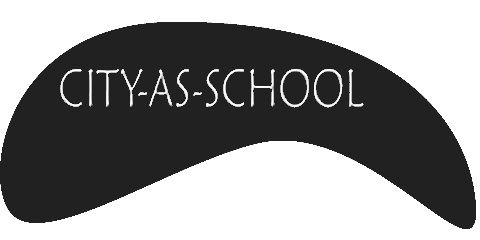

| About City-As-School | Target Students | Program Procedures | Program Outcomes | Statistical Profile |
|
Many
young people ask why they have to learn something before sitting down to the
task.� Absent an answer in their own
terms, they remain at the margins of school culture, with poor attendance and
lack of achievement.� At the same time,
professionals throughout the community wishing to contribute materially to
their community�s betterment are looking for ways to make creative contact with
youth.� Many of these people have both
the energy and the means to be excellent teachers, but lack an opportunity to
do so. City-As-School
is the nation�s leading external learning, or experiential learning, model for
high school students.� Since 1972, we
have been continuously evolving a program for putting students in the field �
primarily students at-risk for dropping out � and revitalizing their interest
in their own lives,� in their education,
and in the society around them.� We
offer a rigorous program that sets high expectations both for our students and
the professionals in the community who work with them.� The experiences are structured to achieve
cognitive as well as affective outcomes.�
The school is remarkable among programs for at-risk youth in that it
motivates gifted-and-talented youth as well as those of more modest
accomplishment.� In 1983, we received
the coveted validations as Developer/Demonstrator from the National Diffusion
Network. |
||||
|
In
the broadest sense, City-As-School is for all students: all students merit the
opportunity to experience the real world, placing their education within a
real-world context.� Our experience has
shown that this is one of the best motivators for better performance within
traditional settings. However, most of the students enrolled in the school have
been identified � by teachers, guidance counselors, or the students themselves
� as being at-risk for dropping out of school.�
It needs to be stated, of course, that many at-risk students have
potentials far and beyond the stereotyped of �dropout.�� Some of these gifted youngsters are turned
off to school because the traditional structure of school, or the social
structure they live in, has failed them. |
||||
|
Following
is a description of the various elements of City-As-School. An Overview The
main elements of the program involve: (1) placing students in the real world to
serve as interns, (2)compensation for their labor and learning in the form of
high school credit toward a diploma, (3)supervision of each placement by a
teacher who creates a curriculum (called a LEAP, for Learning Experience
Activity Package) for the site and monitors student progress, and (4) a minimum
once-a-week meeting in school for each student with an advisor.� There is no wage: �payment� is in high
school credit only. Earning Credits The
credit students receive is based on the amount and kind of work they do.� Thus, working with an editor or drafting
correspondence in an office gives English credit, working in a government
agency or with nonprofit advocacy group allows social studies credit and
helping an accountant or quality control engineer leads to math credit.� (In New York State, a diploma is awarded
after four years of study and the attainment of forty credits.� At the end of one cycle, students receive
one credit for every eight-hour-per-week experience they serve in; two full
business days per week equal two credits, two six-hour days equal
one-and-a-half credits.) During
registration periods, students create their own schedules, combining
resources (internships) and classes in any combination they see fit
to fulfill credit need, interest, and schedule.�
By transferring to City-As-School, where the school day can be
long as a full business day, students who have dropped behind their
peers can proceed at a slightly more rapid pace, �catch up,� and thus
graduate on time.
The Resource
Coordinator The
teacher responsibility for resource (internship) supervision is called a
resource coordinator.� Resource
coordinators are responsible for: (1) creating resources and evaluating the
educational potential of each; (2) writing a description of each resource for
the course catalog; (3) orienting community resource persons in their new role;
(4) writing a curriculum for each placement; (5) finding a proper match between
resource and student during registration; and (6) monitoring student progress through
phone calls, on-site visits, and evaluation of student assignments. The Resource Person The
site supervisor is called a resource person.�
The two prime criteria for selecting a resource person are: (1) concern
for young people and a desire to work with them, and (2) the willingness to
provide them with real activities.� Many
City-As-School students have records of truancy which would make absence the
easiest solution if they did not like their resources.� Thus, City-As-School students, apprenticed
to people as diverse as blacksmiths and lawyers, are given real activities,
from working with metal (i.e., not just cleaning up the workshop, although that
might reasonably be expected in some cases) to doing legal research by reading
the law, looking up indexes, or accompanying the lawyer to court.� The range of placements, and activities at
those placements, means that City-As-School can provide rich environments for
gifted as well as those more in the mainstream. In-House Component City-As-School
students have access to a full range of classes within the school.� In addition, there is a once-a-week meeting
called seminar which is required of all students.� These meetings are run by a teacher called an advisor � the
resource coordinator�s in-house counterpart.�
They typically include discussions of activities at resources, and various
values-clarification and group exercises.�
Advisors� specific in-house responsibilities include: (1) first-level
guidance counselor duties that involve counseling a caseload of students, and
(2) teaching subject classes. Choice and
Responsibility Characteristic
of City-As-School is the effort made to give students choice and
responsibility.� Beginning with the admissions
process, the student takes responsibility for his/her own learning by
submitting a writing sample and interviewing, both with the admissions coordinator
and, post-admissions, with students.�
During registration, students must market themselves as being the best
candidate for that internship.� The
student then must pass another hurdle by setting up an interview with the
resource person (site supervisor).� The
entire program focuses on teaching students what happens in the real world, as
contrasted with the somewhat protected environment of traditional schools.� Choice and responsibility are key. Within
this structure, students are not simple sent out into the world with the
responsibility of calling in from time to time, but instead function within a
strong framework of adult supervision.�
They work one-to-one with an adult at their placements, counsel on a
regular basis with their resource coordinator, and also report to their advisor
on a weekly basis. Students
are encouraged to change resources four times a year to provide a maximum range
of experience before graduation.� At
every step, this requires a process of negotiation that asks students to make
decisions regarding their education and their future. Real-world
experiences + real-world responsibilities + creative adult supervision = success
for students across entire range of abilities and potentials. |
||||
|
Seventy-eight
percent of students at the home school finish with a diploma, although most had
been considered at risk- for dropping out prior to coming to the school.� Seventy-five percent continue directly on to
four-year and two-year colleges, or other vocational training.� Adopting sites around the nation report similar
results and great satisfaction.� From
tiny beginnings, the home school now resides on three campuses, with a staff of
90 and a student body of 950. City-As-School
has received several awards and grants on the basis of evidence submitted
verifying its effectiveness.� Most
prestigious has been selection as a Developer/Demonstrator Project for
the National Diffusion Network, a project within the United States Department
of Education which identifies and disseminates models of Education excellence.�
Under its auspices, City-As-School has conducted more than 60
trainings across the nation for school districts � urban, suburban,
and rural � that wish to create an experiential learning component for
their school.
Student, Staff, and
Community Benefits In
addition, the following outcomes have been noted, for students, staff, and
community. �
Increased self-esteem. �
Increased student motivation. �
Better relationships between students, parents,
and school personnel
as students begin to find success in school. �
Students� understanding that they can play an
active role in shaping their education and future. �
Increased sense of belonging to the larger
community. �
Increased school attendance. �
Better organization and work habits. �
Greater credits earned. �
Higher graduation rate. �
Increased enrollment in college and other kinds
of training after high school. �
Widening of students� career and schooling
horizons. �
Realization by formerly �turned-off� students of
the importance of academics and other classroom training, so they can fulfill
larger and more creative roles within their fields of interest. �
Potential job placement after school hours or
post-graduation. �
Mentoring of individual students by adults in a
unique position to help them. �
Greater participation by the community in the
education process, benefiting individuals in the sense of their own personal
growth and development, and also benefitting the community-at-large, through
the drawing together of two usually separate strands of public endeavor. |
||||

|
||
|
|
||
|
visitor number 1534 |
e-mail us: |
CAS Sites in New York |